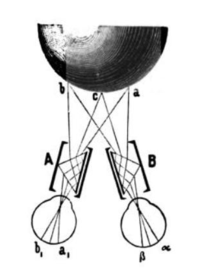
Pseudoscope
Encyclopedia

Optic
Optic may mean:* optic, a British term for a device for dispensing fixed amounts of alcoholic spirits* Optics, the study of the behavior and properties of light* An optical element or component, such as a lens, prism, or mirror...
al instrument
Tool
A tool is a device that can be used to produce an item or achieve a task, but that is not consumed in the process. Informally the word is also used to describe a procedure or process with a specific purpose. Tools that are used in particular fields or activities may have different designations such...
that reverses depth perception
Depth perception
Depth perception is the visual ability to perceive the world in three dimensions and the distance of an object. Depth sensation is the ability to move accurately, or to respond consistently, based on the distances of objects in an environment....
. It is used to study human stereoscopic perception. Objects viewed through it appear inside out, for example: a box on a floor, would appear as a box shaped hole in the floor.
It typically uses sets of optical prisms, or periscopically arranged mirrors to swap the view of the left eye with that of the right eye.
Purpose
In the 1800s Charles WheatstoneCharles Wheatstone
Sir Charles Wheatstone FRS , was an English scientist and inventor of many scientific breakthroughs of the Victorian era, including the English concertina, the stereoscope , and the Playfair cipher...
coined the name from the Greek ψευδίς σκοπειν -- "false view". The device was used to explore his theory of stereo vision.
Effect
Switching the two pictures in a standard stereoscope changes all the elevatedparts into depressions, and vice versa. The pseudoscope produces these inversions also, it
changes convex into concave, and high-relief into low-relief.
But the pseudoscopic inversion of a complicated picture — a landscape, streets, etc., produces a bewildering impression. It seems as if all the objects — men, trees, etc., had been placed in a depression of the earth, and yet everything remains in its place. Therefore, nearer objects appear very large, because we imagine them to be at a great distance, and more distant objects smaller, because they seem to be nearer.
History


Charles Wheatstone
Sir Charles Wheatstone FRS , was an English scientist and inventor of many scientific breakthroughs of the Victorian era, including the English concertina, the stereoscope , and the Playfair cipher...
, who published his ideas in his second great paper "On Binocular Vision," in the Philosophical Transactions for 1852. Wheatstone's paper stimulated the investigation of binocular vision and many variations of pseudoscopes were created, chief types being the mirror or the prismatic.
In 1853 the American scientist John Leonard Riddell
John Leonard Riddell
John Leonard Riddell was a science lecturer, botanist, geologist, medical doctor, chemist, microscopist, numismatician, politician, and science fiction author in the United States. He was born in Leyden, Massachusetts, the son of John Riddell and Lephe Gates. He received his B.A. and M.A...
(1807-1865) devised his binocular microscope, which contained the essentials of Wheatstone's pseudoscope.

